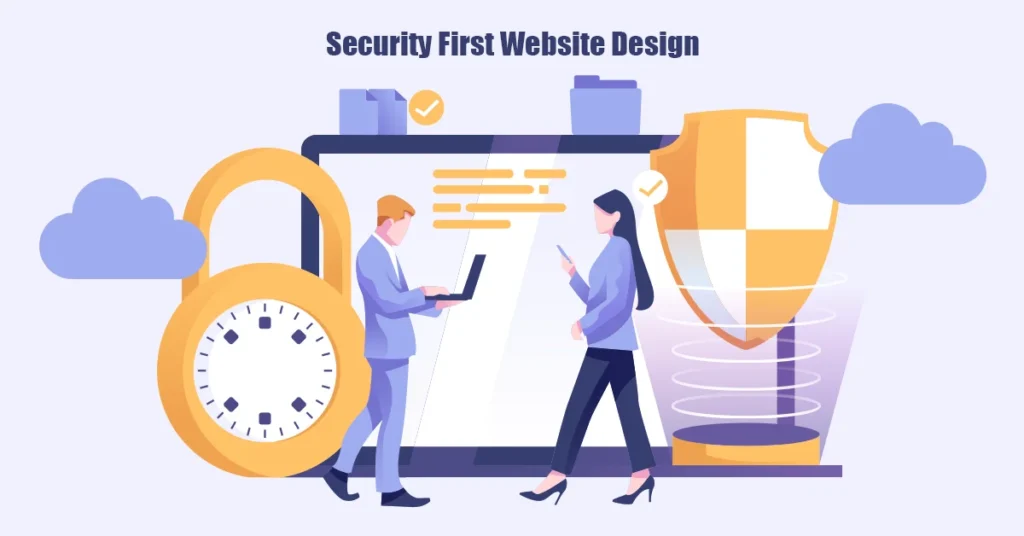
In today’s digital landscape, web security demands a proactive, forward-looking approach. Building a secure web design is essential to counter evolving cyber threats and ensure a secure site. Every aspect of the design process should inherently prioritise security, ensuring it forms the foundation of development from the very beginning. Web developers must integrate comprehensive security protocols early on, focusing on safeguarding user data by selecting trusted hosting solutions and implementing stringent access controls.
Encryption plays a pivotal role in this framework, ensuring data integrity and confidentiality. Secure Sockets Layer (SSL) certificates are crucial for establishing secure, encrypted connections between web servers and browsers. Regular software updates are critical to keeping the website secure, while constant vigilance remains a key requirement for sustainable security. Adhering to modern security standards not only shields the website but also fosters trust among users. Ultimately, designing with security at the forefront helps create a safer, more resilient online environment.
Understanding Your Audience and Security Needs

Grasping your audience’s needs is fundamental in web design, especially when addressing security concerns. Conducting a comprehensive analysis of user demographics enables the creation of a secure and tailored user experience, which in turn strengthens trust and engagement.
Identifying User Demographics
Exploring user demographics such as age, location, and interests provides valuable insight into behaviour, allowing designers to craft user-centric websites. These insights inform the design process, ensuring that the website meets user expectations.
Analysing User Behaviour
Studying how users interact with a website reveals critical patterns that shape design decisions. By aligning security features with user behaviour, designers can create seamless, secure experiences that boost both functionality and trust.
Assessing Security Expectations
Understanding users’ security concerns is key to delivering a website that meets modern privacy expectations. Today’s users demand robust protection of their data, and addressing these concerns directly enhances the user experience and reinforces a sense of security.
Defining Requirements for Security First Website
Establishing clear security requirements is essential for a secure web environment. A well-defined approach to data protection ensures the safeguarding of user privacy, while also adhering to industry standards and regulations.
Data Protection Needs
Security requirements vary, particularly where sensitive data is involved. An encrypted link, established through SSL (Secure Sockets Layer) certificates, is crucial for protecting data during transmission between a web server and a user’s browser. Strong encryption, secure access controls, and stringent data management policies are integral to protecting user information, and these must be woven seamlessly into the web design. Additionally, using a password manager is recommended for generating and managing strong passwords, ensuring enhanced security.
Addressing Privacy Concerns
Privacy is a significant factor in earning user trust. By implementing transparent and privacy-focused practices, websites and services can reassure users that their data is respected and protected, leading to an improved user experience and deeper trust.
Setting Clear Objectives for Secured and Strategic Web Design Plan

Defining clear security objectives in web design is vital for establishing a strong defence against evolving threats. A strategic approach to these objectives informs the entire design process, with a focus on safeguarding user data and ensuring a secure, user-friendly experience.
Establishing Security Goals
Security goals serve as the backbone of any secure website. These objectives guide the development of a comprehensive strategy, ensuring that security is embedded at every stage of the design process. Clearly defined goals not only fortify protection but also enhance user confidence and satisfaction.
Short-term Security Objectives
Short-term objectives address immediate vulnerabilities and aim for swift improvements in security. Measures such as implementing robust password protocols, encryption, and regular software updates are crucial for quick wins. Keeping software up to date is essential for safeguarding against vulnerabilities, as outdated software, including content management systems (CMS) and plugins, can pose significant security risks. These efforts create an immediate impact, significantly improving the overall security posture of the website. Implementing two-factor authentication (2FA) is also vital in preventing unauthorized access by adding an extra layer of verification beyond just passwords.
Long-term Security Vision
A forward-thinking security vision is essential for sustained protection. This long-term approach includes continuous education on emerging threats and the adoption of cutting-edge security technologies. A proactive vision ensures that web design remains resilient and aligned with future challenges.
Aligning Security with Business Goals
Security objectives must be aligned with broader business goals to create a cohesive and balanced strategy. This alignment ensures that web design not only prioritises protection but also supports business growth and operational success. When security measures align with business objectives, both users and stakeholders benefit from a unified approach.
Balancing Security and Usability
A delicate balance between security and usability is fundamental in web design. Strong security features must be seamlessly integrated without disrupting the user experience. The key is to design a secure yet intuitive website, where usability remains uncompromised while robust security measures are actively at work in the background.
Integrating Security into Business Strategy
Embedding security within the broader business strategy strengthens organisational objectives. When security becomes a core element of the business model, it supports the alignment of web design with overall company goals. This strategic integration promotes sustainable growth while ensuring that security remains a cornerstone of the business.
Developing a Content Strategy with Security in Mind

Building a web design strategy that prioritises content security is crucial for fostering user trust and ensuring long-term website integrity. A well-crafted content strategy must place content protection at its core, reinforcing the overall security of the website.
Secure Content Management
Effective content management is fundamental to a secure website. This process involves safeguarding sensitive data, whether it’s user-generated content or proprietary information. A robust content management system (CMS) must integrate comprehensive security protocols, ensuring that data remains protected at every stage.
Content Access Controls
Implementing stringent content access controls is key to preventing unauthorised access. By limiting user permissions, only authorised individuals and businesses can view, edit, or manage content. These controls serve as a critical barrier against potential breaches, reinforcing the security of sensitive information within the website’s framework.
Secure Content Delivery
Ensuring that content is delivered securely to users is equally important. Preventing cross site scripting (XSS) attacks is crucial in secure content delivery, as XSS can allow attackers to inject harmful scripts into a website, potentially compromising user data and security. Encryption methods, such as SSL/TLS, protect data in transit, preventing interception or unauthorised access. A secure delivery system not only protects the integrity of the information but also boosts user confidence, demonstrating that the website is both trustworthy and reliable. Additionally, implementing a web application firewall (WAF) can protect against malicious traffic and enhance overall site security.
Protecting User-Generated Content
Securing user-generated content is essential for preserving website integrity and protecting user data. A comprehensive design strategy should address potential threats by closely monitoring and filtering this type of content to mitigate risks effectively.
Moderation and Filtering
Moderation and filtering systems are critical for safeguarding against malicious content. These mechanisms identify and remove harmful material, ensuring the platform remains secure and user-friendly. By incorporating advanced filtering tools, a strategic web design plan can effectively prevent unwanted activities and maintain a safe environment for users.
Preventing Content Injection and Cross Site Scripting
Content injection, a significant threat to web security, can compromise sensitive user data. To counter this, strong security protocols must be implemented to block potential vulnerabilities. A well-crafted web design strategy places the prevention of content injection as a top priority, reinforcing the website’s defences against this common attack vector.
Integrating Security into Design
A strategic web design plan must weave security into every stage, creating a cohesive framework and reliable platform that not only protects user-generated content but also fosters trust and credibility. By adopting a security-first approach, the overall user experience is enhanced, establishing a safe and reliable digital space.
Designing a Secure Information Architecture
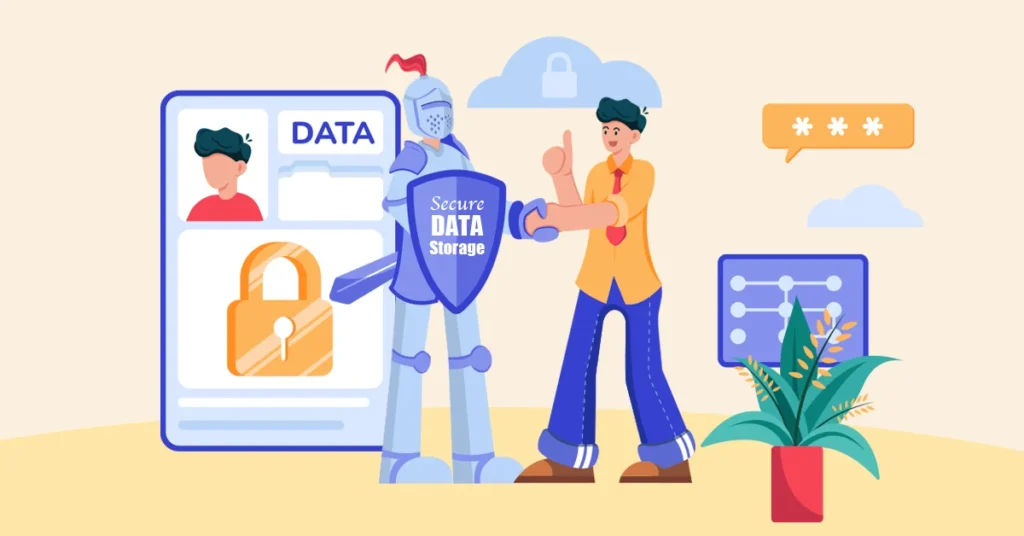
A secure information architecture is the foundation of a strong, resilient website. Prioritising security in the structure of data and navigation is critical for protecting user information and building long-term trust with users.
Structuring Content and Data Securely
Designing a secure data structure requires careful planning and attention to detail. Sensitive information must be protected from unauthorised access by employing advanced strategies that ensure data security and integrity. A well-organised structure strengthens the overall reliability of the system.
Data Segmentation
Data segmentation, by categorising information into distinct groups, plays a crucial role in limiting access. This controlled approach enhances security by isolating sensitive data, reducing the potential impact of breaches and data loss, and protecting user information through strict access management.
Secure Data Storage
Ensuring secure data storage is essential in defending against potential threats. Preventing SQL injection attacks is crucial as they allow malicious users to execute unauthorized SQL commands and manipulate database data. Strong encryption and robust storage solutions help maintain data confidentiality and prevent unauthorised access. When users know their data is stored securely, it bolsters their confidence in the website’s overall security posture. Validating and sanitizing user input is necessary to protect data integrity and prevent malicious activities.
Implementing Secure Navigation Elements
A well-designed navigation system that prioritises security significantly improves both usability and data protection. Secure navigation not only guides users effectively through the site but also minimises vulnerabilities that could be exploited, enhancing the overall user experience.
Secure URL Structures
Secure URL structures are integral to maintaining web security. Developers must construct URLs that are both clear and protected against unauthorised access. A secure, well-organised URL system fosters user trust and reduces the likelihood of attacks aimed at manipulating web addresses.
Safe Internal Linking
Safe internal linking practices ensure that users navigate the site securely while protecting sensitive data throughout the journey. By focusing on secure, reliable links, developers enhance the overall browsing experience and build a seamless, protected environment for users.
Mobile Optimization with Security Considerations
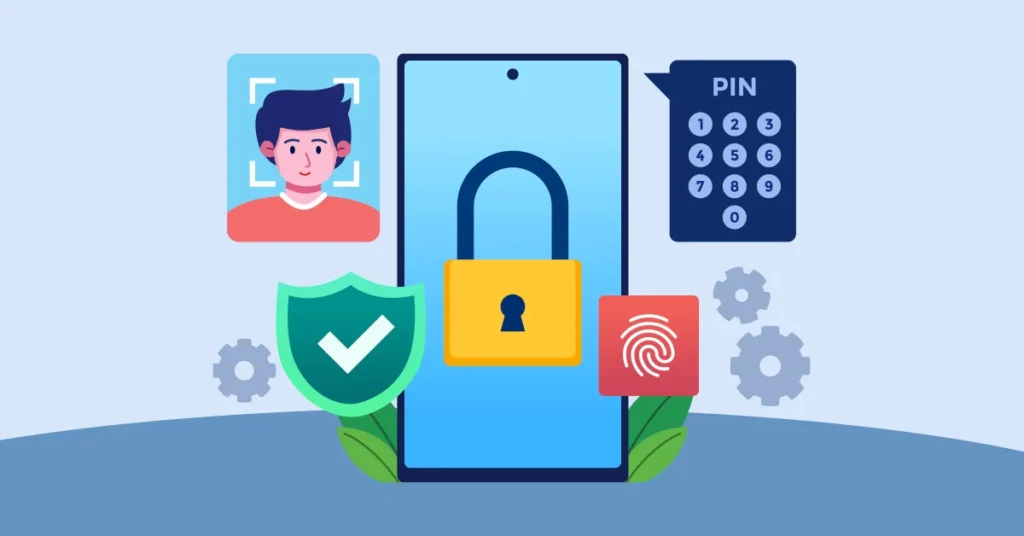
Mobile optimisation demands a strong emphasis on security, as users expect a seamless and secure experience on their mobile devices. Developers must ensure both mobile data security and responsive design, creating an environment that fosters user trust and satisfaction.
Ensuring Mobile Data Security
Mobile data security is paramount, with users expecting their personal information to be protected at all times. Developers must prioritise secure connections and the safeguarding of data to meet these expectations.
Secure Mobile Connections with Two Factor Authentication
Encryption plays a critical role in protecting data during transmission, ensuring confidentiality is maintained. For business websites, secure connections are crucial to protect sensitive customer information during online transactions. Developers must implement secure protocols, such as HTTPS and SSL, for mobile connections to guarantee the safety of user interactions, thereby increasing user confidence. Proper web server management is essential in implementing HTTPS encryption for mobile connections, ensuring robust security measures are in place.
Protecting Mobile User Data
To secure user data, developers should employ robust security measures, including strict access controls and advanced encryption techniques. Secure data storage prevents unauthorised access, and users will value the extra effort taken to protect their personal information.
Responsive Design and Security
Responsive design enhances the user experience across devices, but security must be integrated into this process. Ensuring that interfaces are intuitive and secure across different screen sizes not only improves functionality but also keeps interactions safe.
Secure Mobile Interfaces
Creating secure and intuitive interfaces is essential for a positive user experience. Developers should focus on clear, user-friendly navigation while embedding strong security measures, allowing users to interact with confidence.
Mobile Security Testing
Routine security testing is crucial for identifying vulnerabilities in mobile applications. Developers must conduct regular tests to verify the effectiveness of security measures, ensuring that the app remains safe over time. Users trust applications that undergo rigorous and consistent security testing.
Enhancing Visual Aesthetics with Security Elements

Incorporating security features into design aesthetics requires a careful balance between functionality and visual appeal. By integrating visual security indicators with user interface security, you can create a website that not only protects users but also fosters trust through thoughtful design choices.
Visual Security Indicators
Visual security indicators are essential for building user confidence. Recognisable symbols, such as padlocks or trust marks, communicate safety and reliability, reinforcing the perception of a secure browsing environment.
Trust Seals and Badges
Trust seals and badges are powerful visual elements that signal the security of a website. Recognised by users as indicators of safety, displaying well-known badges prominently helps reassure visitors about the credibility of the site. Placing these elements strategically increases their visibility and impact.
Secure Design Elements
The overall design should reflect security through consistency in colours, fonts, and layouts. A professional, cohesive aesthetic promotes confidence, making users feel that the site is both visually appealing and secure. Thoughtfully integrating secure design elements enhances the user experience, where visual appeal supports functionality and trust.
User Interface Security
User interface security is vital for safeguarding interactions across the website, ensuring that users can navigate and input data without risk. A focus on secure forms and interactions strengthens trust and promotes a seamless, safe user experience.
Secure Form Design
Designing secure forms involves implementing encryption and other protective measures to shield user data. Clear, concise instructions and feedback help users complete forms confidently and correctly, reducing errors and enhancing trust. A well-secured form not only protects sensitive information but also boosts user confidence in the website’s reliability.
Safe User Interactions
To ensure safe user interactions, careful planning is essential. All interactive elements, from buttons to navigation menus, must function securely to meet user expectations. By providing a seamless and responsive interface, you create a secure environment where users can interact confidently, ultimately fostering loyalty and satisfaction.
Focusing on Conversion and Security Optimization

Integrating security into conversion paths is essential for building user confidence and trust. A secure conversion process not only protects sensitive information but also enhances the overall user experience, ensuring that safety and reliability are prioritised at every stage.
Secure User Experience Conversion Paths
A secure conversion path is key to safeguarding user data during crucial interactions. A well-designed process should guide users smoothly while implementing necessary security measures to protect their personal and financial information, ensuring a seamless and protected experience.
Protecting Checkout Processes
The checkout process is particularly vulnerable, requiring robust security protocols. Securing web apps is crucial in protecting checkout processes, as they enable efficiency and facilitate customer interaction. Encryption ensures the confidentiality of payment data, while secure payment gateways prevent unauthorised access. By prioritising security in the checkout process, users are more likely to trust the transaction and complete their purchase confidently. Website security plays a vital role in safeguarding payment data during transactions, ensuring that user information remains protected from various threats and vulnerabilities.
Secure Call-to-Actions
Call-to-actions (CTAs) must be designed with security in mind. Clear and secure CTAs lead users confidently through the process, minimising risks associated with data breaches. A well-executed, secure CTA not only encourages user engagement but also reinforces trust through a seamless and protected interaction.
Building Trust with Security as Part of must have Strategic Web Design Plan
Building trust is rooted in demonstrating transparent security practices. Users appreciate brands that prioritise their safety, and a commitment to security fosters long-term customer relationships built on trust.
Transparency in Security Practices
Being open about security protocols significantly boosts user confidence. When brands clearly communicate their security measures, users feel reassured that their data is protected. This transparency, where brands openly share their efforts to safeguard information, creates a foundation of trust and loyalty.
Communicating Security Measures
Effectively communicating how security measures protect user data is crucial for strengthening a brand’s reputation. Providing clear and accessible information about these practices helps educate users, making them feel confident in interacting with the site. Comprehensive guides, similar to those found on platforms like HubSpot, offer users insight into how their data is being handled, reinforcing trust through transparency.
Security as a Competitive Edge
By focusing on secure conversion paths and transparent communication, a brand can differentiate itself in the market. Prioritising security not only protects users but also provides customers with a strategic advantage, positioning the brand as trustworthy and reliable in a competitive landscape.
Ensuring Accessibility and Security

A secure, accessible design ensures that all users can engage with a website safely, regardless of their abilities. Following Web Content Accessibility Guidelines (WCAG) helps create inclusive digital environments where security and accessibility are both prioritised.
Secure Accessible Flow
Secure design should be universally accessible, providing every user with full support and a safe experience. WCAG offers a solid framework for building sites that cater to diverse user needs, ensuring that security is seamlessly integrated with accessibility features, giving all users a secure and inclusive online experience.
Inclusive Security Features
Incorporating inclusive security features is vital to ensure that users with disabilities can access secure content. Developers must include features like screen reader compatibility and keyboard navigation to enhance the experience for everyone. By embracing inclusivity, developers not only improve usability but also contribute to the overall security of the site, creating a more robust and accessible digital environment.
Accessible Security Alerts
Security alerts should be designed to accommodate a wide range of user needs. By using clear language, visual cues, and accessible formats for users with specific needs, such as those with colour blindness or cognitive impairments, developers ensure that all users remain informed about potential threats. Effective, accessible alerts are essential in keeping users safe and well-informed.
Balancing Accessibility and Security for Users
Achieving the right balance between accessibility and security is key to creating an inclusive and secure user experience. Developers must consider both aspects carefully, ensuring that security features do not compromise accessibility, ultimately fostering trust and satisfaction.
Avoiding Security Barriers
To maintain accessibility, security features should not create barriers for users with disabilities. For instance, alternatives to traditional CAPTCHA, such as audio or image-based options, must be provided to ensure inclusivity. A barrier-free approach ensures that security measures protect all users without impeding access.
Enhancing User Experience
Integrating security within an accessible design enhances the overall user experience. Developers must ensure that navigation is both intuitive and secure, making it easy for users to interact safely. Websites that seamlessly blend security with usability build user confidence, encouraging loyalty and long-term engagement.
Optimising Performance with Security
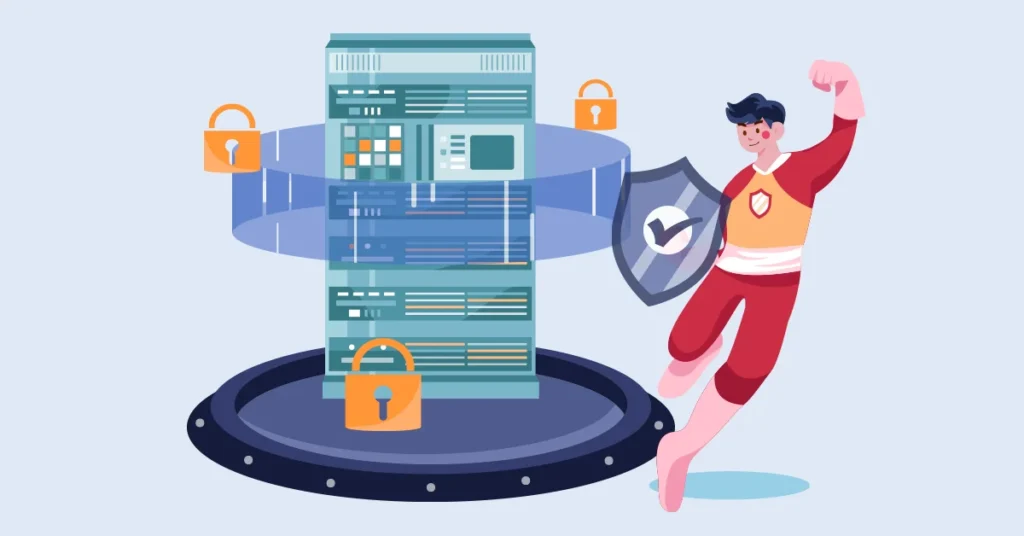
Striking a balance between performance and security is crucial in web design. Enhancing speed without compromising security ensures a smooth and protected user experience.
Secure Performance Enhancements
Optimising a website for both speed and security creates a seamless browsing experience. Security measures, such as encryption, should be integrated into performance optimisations to ensure data integrity.
Fast and Secure Loading
Fast loading speeds are essential for user satisfaction, and security must be maintained throughout the process. Leveraging Content Delivery Networks (CDNs) helps distribute content efficiently, reducing latency and improving load times. Encryption protocols safeguard data during transmission, ensuring users enjoy both speed and secure browsing.
Secure Caching Techniques
Caching improves performance by storing frequently accessed data, but it must be done securely. Secure caching techniques, including cache-control headers, prevent unauthorised access to stored data. Regular cache purging ensures that sensitive or outdated information is removed, allowing for faster load times while maintaining security.
Monitoring Performance and Security
Effective monitoring of both performance and security is essential to maintaining a safe, high-functioning website hosting service. A proactive approach ensures that potential threats are identified and addressed quickly, while also optimising performance.
Real-time Security Monitoring with Web Application Firewall
Real-time monitoring is crucial for detecting security threats as they occur. Using tools like Intrusion Detection Systems (IDS) helps identify suspicious activity, while automated alerts notify administrators of potential breaches. Continuous monitoring enables rapid responses to threats, reassuring users that their data is protected through proactive security measures.
Performance Security Audits
Regular performance and security audits are key to identifying vulnerabilities and performance bottlenecks. These audits review server configurations, application code, and system performance, highlighting areas for improvement. By implementing the recommendations from these audits, both security and performance are enhanced, giving users confidence in a website that prioritises both safety and efficiency.
Implementing SEO with Security in Mind

Integrating security into SEO strategies ensures that your website remains both highly visible and secure. By focusing on secure SEO practices, you protect user data, maintain search engine rankings, and foster user trust. A security-first approach to SEO also contributes to long-term online visibility and credibility.
Secure SEO Practices
Secure SEO practices are essential for building a trustworthy and compliant website. These practices not only align with search engine guidelines but also protect sensitive user information, ensuring that both search engines and visitors view your site or service as reliable.
HTTPS and SEO
HTTPS is a crucial factor in modern SEO. Understanding web application security is essential in maintaining search engine rankings. Search engines favour websites using HTTPS because it encrypts the data transmitted between the server and the user, enhancing security. Implementing HTTPS improves your site’s search ranking and reassures users that their personal information is protected, boosting both visibility and trust. Secure web design plays a vital role in protecting user data and enhancing SEO.
Secure Metadata
Secure metadata is key to effective SEO. Metadata provides search engines with relevant information about your site’s content, and by securing it, you prevent errors and unauthorized alterations. Ensuring the accuracy and security of metadata not only improves search engine visibility but also reinforces user trust by accurately representing the content’s relevance and safety.
Avoiding Search Engine Optimisation Security Pitfalls
Steering clear of SEO security pitfalls is essential for maintaining your website’s integrity and avoiding penalties from search engines. A proactive and ethical approach to SEO security helps safeguard your online presence and ensures sustainable growth.
Preventing Black Hat Techniques
Black hat SEO techniques, such as keyword stuffing, cloaking, and link schemes, can severely harm your website’s rankings and credibility. Search engines actively penalise sites that employ these manipulative tactics. By avoiding black hat methods, you ensure your website remains compliant, ethical, and trustworthy. Users value sites that adhere to transparent and ethical SEO practices, enhancing long-term trust.
Secure Backlink Strategies
Backlink strategies play a vital role in improving SEO, but the focus must remain on quality over quantity. Backlinks from secure, reputable sources not only enhance your site’s authority but also drive relevant traffic. Ensuring that these links come from credible, secure websites protects your site’s reputation and boosts user trust. High-quality backlinks demonstrate to users that your content is valuable and trustworthy.
Testing, Iteration, and Analytics for Security
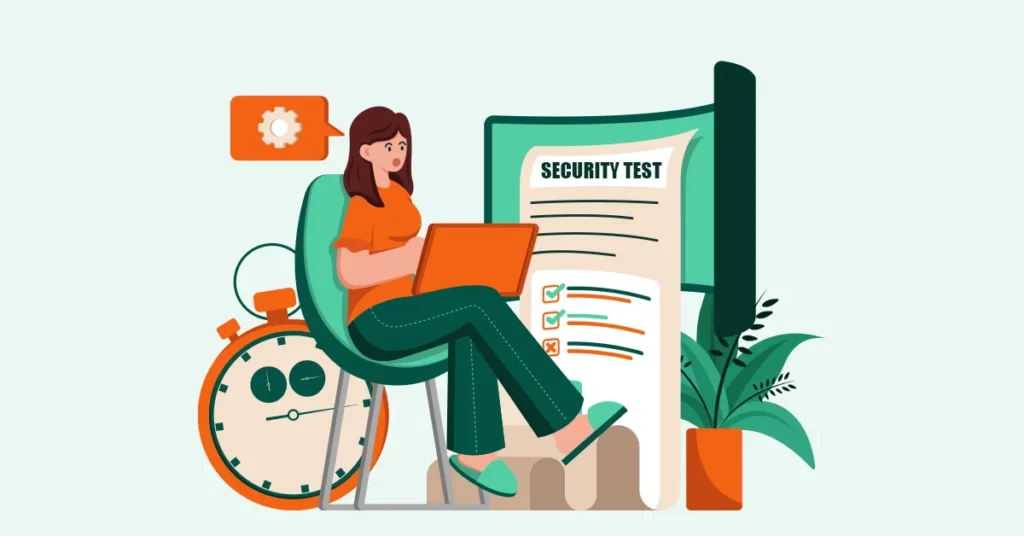
Thorough testing and continuous improvement are essential to maintaining a secure website. By conducting regular security assessments, you can identify and address vulnerabilities, ensuring your website remains resilient against potential threats.
Conducting Security Testing for your Audience
Security testing plays a crucial role in safeguarding user data and protecting a website from cyber threats. Comprehensive testing helps identify weaknesses that could be exploited, allowing for proactive adjustments that strengthen the overall security posture.
Penetration Testing
Penetration testing simulates real-world cyberattacks, providing valuable insights into the effectiveness of current security measures. Conducted by security professionals, these tests expose vulnerabilities that might otherwise go unnoticed. Addressing these weaknesses enhances the website’s ability to defend against future attacks.
Vulnerability Assessments
Vulnerability assessments provide an in-depth analysis of potential risks, offering a clear roadmap for improvement. Regular assessments help identify areas that may require updates or modifications to ensure the website remains secure. Implementing the recommendations from these assessments reduces the risk of security breaches over time.
Iterating Based on Security Analytics
Security analytics provide crucial insights into a website’s performance, helping identify patterns and trends related to potential vulnerabilities. Analyzing this data is essential for making informed improvements to security measures.
Analyzing Security Data
Examining logs and security reports helps detect unusual activities or emerging threats. By analysing this data, developers can pinpoint vulnerabilities and take proactive action. A data-driven approach not only strengthens the security strategy but also improves the ability to respond swiftly to any risks.
Continuous Security Improvement
Continuous security improvement is key to staying one step ahead of evolving threats. Regularly updating security protocols and monitoring industry trends ensure a website remains protected. By adapting to new challenges and incorporating the latest security practices, a site can maintain a robust and resilient security posture.
Security First Website Design Approach for Ultimate User Experience
A security-first mindset is essential for modern web development. Prioritising security at every stage ensures the protection of user data and the integrity of the website. Vigilance, including regular updates and security audits, reinforces resilience against threats. A commitment to ongoing security not only builds trust and confidence but also fosters a safe and secure online environment.




